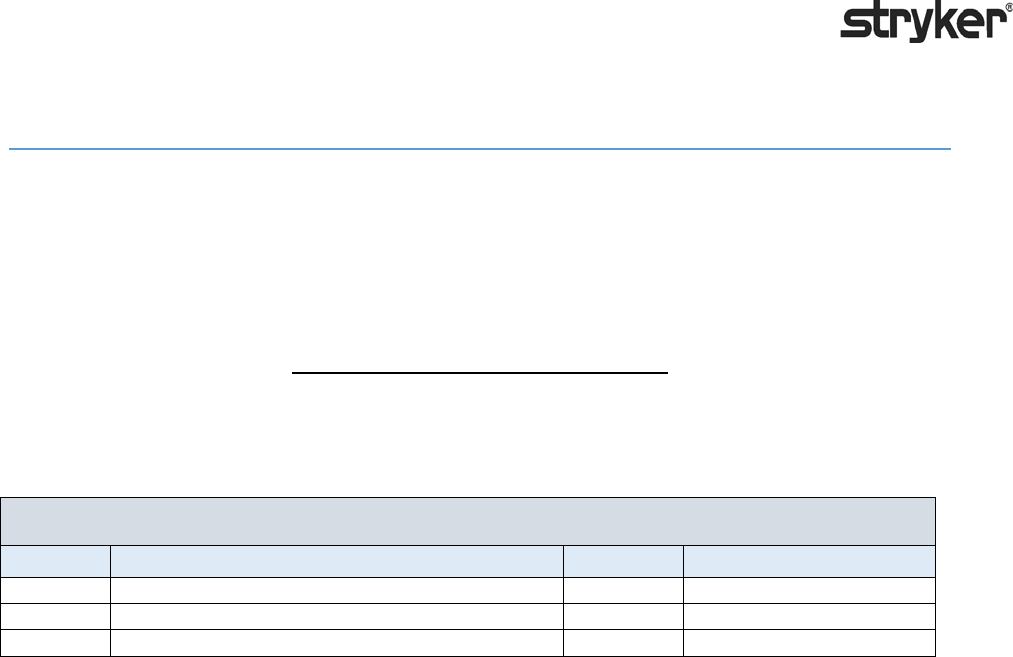Stryker Instruments 0703001820 RFID Module User Manual
Stryker Instruments RFID Module
User Manual

Page 1 of 3
User’s Guide
Manifold Receptacle (MR) Printed Circuit
Board Assembly (PCBA)
Stryker PN: 0703-001-820
Document Rev: 1.1
R
EVISION
H
ISTORY
REVISION
COMMENTS
DATE
AUTHOR
0.1
I
NITIAL CREATION
.
10/11/2015
G.
R
OCQUE
1.0
U
PDATED FROM DESIGN REVIEW
10/14/2015
G.
R
OCQUE
1.1
UPDATED FROM NEMKO TCB COMMENTS
12/2/2015
G. ROCQUE
Description:
The Manifold Receptacle (MR) Printed Circuit Board Assembly (PCBA) is a custom designed circuit board
intended to operate only within the Neptune 3 Rover and next generation of Neptune product line. The
MR PCBA is made up of a custom mother board, Stryker PN 0590-085-340, an off the shelf RFID Reader
daughter card, Stryker PN 0703-001-821, and an integrated antenna. Together, the mother board, the
off the shelf RFID Reader daughter card, and integrated antenna constitute the Stryker MR PCBA,
Stryker PN 0703-001-820. The mother board is manufactured by Stryker while the off the shelf RFID
Reader daughter card is manufactured by Feig Electronics, PN 4320.000.00.
Features:
The MR PCBA is made up of an RFID interface circuit to communicate with the RFID Reader daughter
card, an illumination circuit for the manifold receptacle, a manifold detection circuit, a DC to DC power
supply, a sprinkler controller circuit, a canister illumination driver circuit, and a UART interface bus to
communicate with the Rover Main Controller (RMC) PCBA. All of the MR PCBA features are custom to
the Neptune 3 Rover system. The MR PCBA cannot operate on its own and is a slave sub-system within
the Neptune 3 Rover system. A set of proprietary commands exist between the RMC PCBA and the MR
PCBA to configure, perform execution of tasks, and transfer data upon command. The proprietary
commands always originate from the master RMC PCBA and are responded to by the slave MR PCBA.

Page 2 of 3
Finally, the MR PCBA contains an integrated RFID antenna designed to read passive HF RFID smart tags.
The integrated RFID antenna is located on the mother board, Stryker PN 0590-085-340.
Technical Data:
Mechanical Data:
Housing: None provide, bare PCBAs only; installed within the Neptune 3 Rover
Dimensions: (W x H x D): 3.31inch x 0.62inch x 4.82inch (84.07mm x 15.75mm x 122.43mm)
Pwr/Comm Connector: 12 Pin-Connector, Samtec, IPL1-106-01-L-D-RA-K, custom wire configuration
Weight: 2.7 oz. (77g)
Electrical Data:
Supply Voltage: 17 VDC to 41.2 VDC
Current Draw: 1.0A Max at 36 VDC Roving Mode or 0.5A Max at 18 VDC Docking Mode
Power Consumption: 36W Roving Mode or 9W Docker Mode
Interfaces: RS485 – Level, 115.2 kbps, Proprietary Communication Protocol
Processor: Microchip dsPIC 33EP256MU810 and Fujitsu MB90F562B
Main RFID Functional Properties:
Reader: Ability to detect, read, and write to passive HF RFID smart tags
Operating Frequency: 13.56 MHz
Distance: Short communication range, 1.5” or less
Ambient Conditions:
Temperature Range: 0°C - 70°C
Humidity: 5 – 95% non-condensing

Page 3 of 3
Federal Communications Commission (FCC) Statement Concerning Radio
Frequency Interference:
This device complies with part 15 of the FCC Rules. Operation is subject to the following two conditions:
1. This device may not cause harmful interference
2. This device must accept any interference received, including interference that may cause
undesired operation.
Changes or modifications not expressly approved by the party responsible for compliance could void the
user's authority to operate the equipment.
Note: This equipment has been tested and found to comply with the limits for a Class B digital device,
pursuant to part 15 of the FCC Rules. These limits are designed to provide reasonable protection against
harmful interference in a residential installation. This equipment generates, uses and can radiate radio
frequency energy and, if not installed and used in accordance with the instructions, may cause harmful
interference to radio communications. However, there is no guarantee that interference will not occur
in a particular installation. If this equipment does cause harmful interference to radio or television
reception, which can be determined by turning the equipment off and on, the user is encouraged to try
to correct the interference by one or more of the following measures:
—Reorient or relocate the receiving antenna.
—Increase the separation between the equipment and receiver.
—Connect the equipment into an outlet on a circuit different from that to which the receiver is
connected.
—Consult the dealer or an experienced radio/TV technician for help.